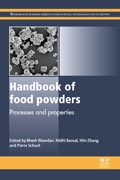
Handbook of Food Powders: Processes and Properties
Bhandari, B
Bansal, Mohan
Zhang, Sam
Schuck, P.
Many food ingredients are supplied in powdered form, as reducing water content increases shelf life and aids ease of storage, handling and transport. Powder technology is therefore of great importance to the food industry. The Handbook of food powders explores a variety of processes that are involved in the production of food powders, the further processing of these powders and their functional properties.Part one introduces processing and handling technologies for food powders and includes chapters on spray, freeze and drum drying, powder mixing in the production of food powders and safety issues around food powder production processes. Part two focusses on powder properties including surface composition, rehydration and techniques to analyse the particle size of food powders. Finally, part three highlights speciality food powders and includes chapters on dairy powders, fruit and vegetable powders and coating foods with powders.The Handbook of food powders is a standard reference for professionals in the food powder production and handling industries, development and quality control professionals in the food industry using powders in foods, and researchers, scientists and academics interested in the field. Explores the processing and handling technologies in the production of food powdersExamines powder properties, including surface composition, shelf life, and techniques used to examine particle sizeFocusses on speciality powders such as dairy, infant formulas, powdered egg, fruit and vegetable, and culinary and speciality products INDICE: Introduction to food powders. Part 1 Processing and handling of technologies: Spray drying for food powder production; Freeze drying for food powder production; Roller and drum drying for food powder production; Modelling crystallization in spray drying for food powder production; Grinding for food powder production; Agglomeration/granulation in food powder production; Fluidization in food powder production; Powder mixing in the production of food powders; Handling of food powders: Flow patterns and storage design; Ensuring process safety in food powder production: The risk of dust explosion. Part 2 Powder properties: Powder properties in food production systems; Techniques to analyse particle size of food powders; Surface composition of food powders; Food powder rehydration; Shelf-life of food powders. Part 3 Speciality food powders: Dairy powders; Infant formula powders; Powdered egg; Tea and coffee powders; Fruit and vegetable powders; Rice flour and related products; Culinary powders and speciality products; Powders containing microorganisms and enzymes; Coating foods with powders.
- ISBN: 978-0-85709-513-8
- Editorial: Woodhead Publishing
- Encuadernacion: Cartoné
- Páginas: 688
- Fecha Publicación: 27/08/2013
- Nº Volúmenes: 1
- Idioma: Inglés
